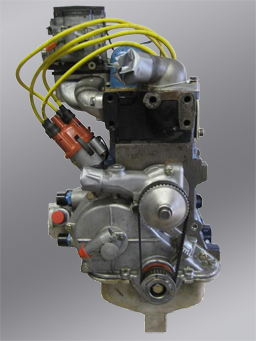The History of the Formula Ford Engine
The history of the Formula Ford engine begins with the English Ford 105E engine in 1959. That engine was used in Formula Junior cars and was followed by the 116E, the first five main-bearing version of which was the basis of the Formula 2 engines built by Cosworth. The one-liter Formula 3 versions typically turned 10,000 rpm and propelled cars driven by many future F1 stars early in their careers. The original Formula Ford engines were from the Ford Cortina and originally cost under 100 pounds sterling.
 The later "uprated” or "Kent” engine used a heavier crankshaft, introduced the flush cylinder head and became the predominant engine used in Formula Ford after its introduction in 1971. In the United States, these engines were found in the '71 - '73 Pinto and later, with some variations, in the Ford Fiesta. As recently as the late 1990's, the 711M Kent blocks from '71-'73 Pintos could be found in choice salvage yards. The Fiesta version - casting number 771M - was made in greater numbers and even today these blocks can be found in salvage yards. This incredible engine is a simple, sturdy, basic design which, when properly blueprinted and tuned by the best FF1600 engine builders, can put out a maximum of about 117 horsepower. When the Kent block is "souped-up" and maximized for use in Caterham cars, the old Formula B or "Atlantic" cars (using heads with double overhead cams) as well as other racing applications, this block can be made to yield as much as 250 horsepower.
The later "uprated” or "Kent” engine used a heavier crankshaft, introduced the flush cylinder head and became the predominant engine used in Formula Ford after its introduction in 1971. In the United States, these engines were found in the '71 - '73 Pinto and later, with some variations, in the Ford Fiesta. As recently as the late 1990's, the 711M Kent blocks from '71-'73 Pintos could be found in choice salvage yards. The Fiesta version - casting number 771M - was made in greater numbers and even today these blocks can be found in salvage yards. This incredible engine is a simple, sturdy, basic design which, when properly blueprinted and tuned by the best FF1600 engine builders, can put out a maximum of about 117 horsepower. When the Kent block is "souped-up" and maximized for use in Caterham cars, the old Formula B or "Atlantic" cars (using heads with double overhead cams) as well as other racing applications, this block can be made to yield as much as 250 horsepower.
Consequently, as run in a Formula Ford chassis and developing about 115-117 horsepower, there is plenty of reserve strength built in. Properly assembled, carefully balanced examples can turn over 7,000 rpm with no trouble and are basically bulletproof - as long as the flywheel ring gear doesn't hit the race track surface!
Because the engine preparation rules are extremely restrictive - essentially allowing little more than blueprinting - maximum power levels are achieved by means of careful preparation of parts and very careful assembly. Reduction of friction is critical and, as with any racing engine, the machine work must be perfect. High quality balancing of the rotating mass is essential. Ring specs and preparation are also very important as are intake/exhaust port flow, ignition timing and carburetor preparation. High horsepower ratings - in the range of 115-117 hp - are achieved by a number of excellent engine builders across the US who have painstakingly developed preparation methods, modifications, prepared parts and various 'secret' techniques to get every possible advantage. Any racer expecting to make the front of the grid at Nationals or at the RunOffs will engage one of the half-dozen premier engine builders to build up and to freshen one or more engines. A complete, new National level engine can cost over $10,000.
But that doesn't leave the Club racer who races on a limited budget - 'for the fun of it' - out in the cold! Sound, serviceable and rebuildable Kent engines can be found for $2,500-3,500 while a good Regional level engine may cost $4,500-5,500. Many die-hard FF racers continue to build up or freshen their own Kent engines either because they are working with limited budgets or for the pure pleasure of the technical exercise that engine building can be. That has been true from the inception of the class in the US. It's one of the primary appeals of Formula Ford since the Kent is a simple and rugged engine and prepared parts are readily available. Using Jake Lamont's book, "How to Build and Maintain Competitive Formula Ford 1600 Engines", a savvy racer can put together a reliable, powerful and long lasting engine for Regional racing.
Ford is planning on producing new engine blocks! See Kent Reborn